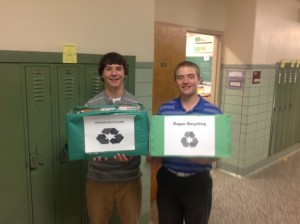Mapping for Change

Originally appears in the Summer 2014 issue
ANYONE WHO WORKS IN a school is aware of how much waste can be produced on a daily basis. With so many people in one location, it is inevitable that a large amount of waste will pile up. A study from Minnesota on the amount of waste produced per capita determined that a
total of 483,250 pounds of waste are produced daily by their K-12 public schools.1 The study classified the waste produced and found the two highest categories produced included food waste (23.9%) and recyclable paper (23.5%). However, many of the paper recycling programs in schools are not implemented with enough direction to ensure their success.
Four years ago, Glenwood Middle School, located in Youngstown, Ohio, started a paper recycling program. The program started with the delivery of a recycling dumpster in the parking lot and an announcement at a faculty meeting that we could begin recycling paper. There were no bins, signs, or methods for collection. There was nobody in charge of procedures and paper recycling was something that would be done as each individual saw fit. Without any kind of direction, there was little support for the program in the beginning. Two years after our paper recycling program began, I decided to involve students in a mapping exercise that would analyze what was working and what wasn’t in order to make sure we were reducing waste as much waste as possible.
To view the photo-rich magazine version, click here.
If you are not already a subscriber, please subscribe to read the full article
Scott Lenhart is an 8th grade science teacher at Boardman Glenwood Middle School in Boardman, Ohio. He is a current student of Project Dragonfly’s Global Field Program through Miami University of Ohio.
Leave a Reply
You must be logged in to post a comment.





